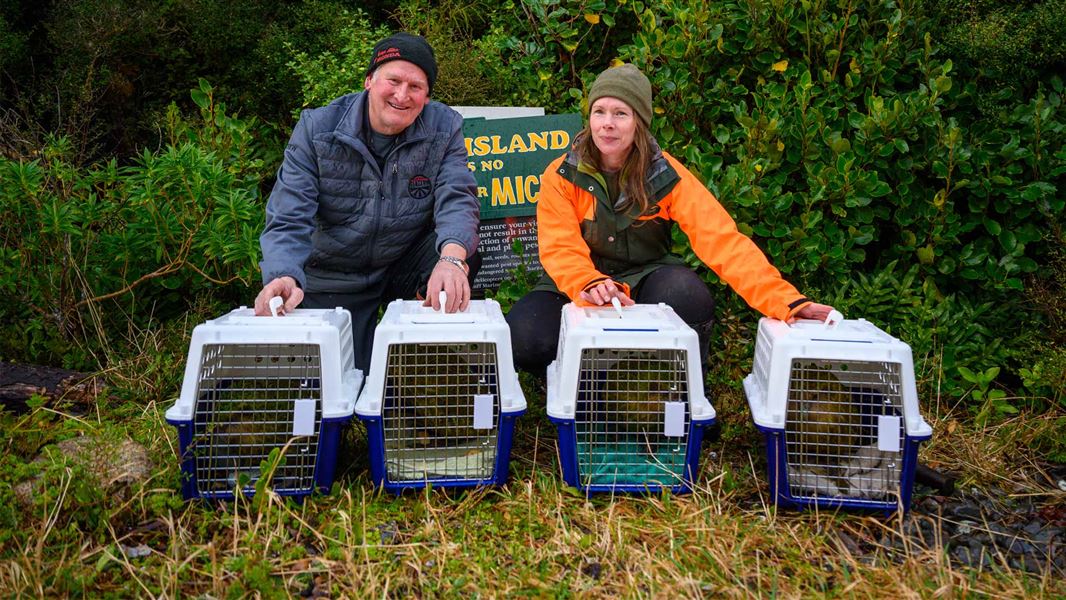Archived content: This media release was accurate on the date of publication.
Date: 28 May 2024
DOC, Ngāi Tahu and Coal Island Trust moved four male kākāpō to the Fiordland site in a bid to investigate whether the 1163 ha island could one day support a larger breeding population.
DOC Operations Manager for Kākāpō Deidre Vercoe says the move is the next step towards solving the kākāpō habitat shortage.
“With a breeding season predicted for 2026, we are looking at new sites to relieve population pressure on the islands that kākāpō currently live on.”
Coal Island, with its similar habitat and proximity to existing breeding islands, could be our next key site, says Deidre.
“The Coal Island Trust has done incredible work over the last couple of decades removing predators to turn the island into a haven for many native species.”
Coal Island Trust chair Ali King says the kākāpō transfer is one of the highlights of the Trust’s 20-year focus on reintroducing native birds to the island.
“So many trustees and volunteers have worked tirelessly for the past twenty years to help make this day possible – this is a huge milestone in our history and will also have deep significance for our iwi partners. We’re proud to have fostered such a strong partnership with DOC, local iwi and other Fiordland entities.
“We have already seen Haast tokoeka/kiwi reintroduced in 2009, followed by yellowhead/mohua and New Zealand robin/toutouwai in 2015 and now these young male kākāpō will call Te Puka-Hereka their home – I couldn’t be happier.”
Ngāi Tahu representative on the Kākāpō Recovery Group, Tāne Davis, says, “A lot of planning and thought from Ngāi Tahu has gone into this decision to introduce kākāpō to Te Puka-Hereka since we first investigated this whenua as a potential new habitat for this taonga species in 2017.”
“Ngāi Tahu acknowledges the important predator control work that has occurred on the island over the past twenty years.
“This mahi gives us hope that this trial will be successful and will extend the available habitat for kākāpō in future,” Tāne says.
As with any new site, there are some unknowns with this translocation, says Deidre Vercoe.
“As long as there are predators such as stoats on the mainland, there will be a risk of reinvasion to any new island site. Coal Island’s extensive trapping network keeps most predators at bay, but stoats do arrive occasionally and there are currently estimated to be one or two individuals present.”
Enhancing stoat monitoring and trialling new control techniques is a focus for the island, which has great potential as a future breeding island for kākāpō, but females won’t be introduced at this stage, Deidre says.
“Ultimately, we need more predator free sites to give kākāpō the best chance to thrive. In the meantime, with the population increasing each breeding season, we need to investigate other options. The males involved with this transfer are fully grown, weighing between 2-4kg, which we believe to be at low risk of stoat predation.
“This new site trial provides us the chance to understand more about the island and the risk of low stoat density to kākāpō, and maybe open the door to more sites in the future.”
The move is part of the Kākāpō Recovery Programme’s future sites plan. As part of this plan, a separate trial investigating whether kākāpō can thrive in a fenced sanctuary is currently underway at Sanctuary Mountain Maungatautari.
The Kākāpō Recovery Programme has been supported since 2016 by National Partner Meridian Energy, which provides funding as well as electrical infrastructure, technology and volunteering support to the programme.
Background information
The kākāpō released were: Elwin, Kanawera, Manawanui, and Motupōhue.
Contact
For media enquiries contact:
Email: media@doc.govt.nz
